Over the past few years, the ANPC has led the revision and publication of the following three guidelines:
- Guidelines for the Translocation of Threatened Plants in Australia (Commander et al. 2018).
- Florabank Guidelines for native seed collection and use (Commander et al. 2021)
- Plant Germplasm Conservation in Australia for ex situ conservation (Martyn Yenson et al. 2021).
These guidelines can be used separately or together to inform plant conservation and restoration in Australia. All guidelines support action towards restoring functional, self-sustaining plant populations by providing guidance on different aspects of this process. Each one brings together current literature and best practice to create an accessible, evidence-based handbook. They also link readers into international guidelines, with relatable Australian examples. The Germplasm Guidelines and Translocation Guidelines also feature case studies that capture collaborative efforts and showcase innovative methods.
This webpage has been developed to help you choose which guideline to use to ensure your valuable time is well spent!
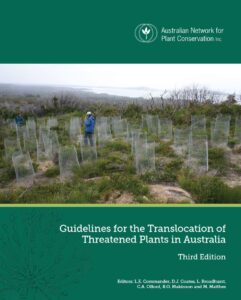 | 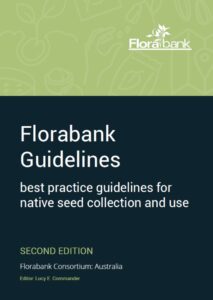 | 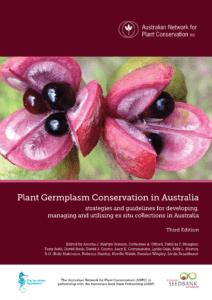 |
| Translocation Guidelines | Florabank Guidelines | Germplasm Guidelines |
| Threatened plant translocation | Seeds for restoration | Ex situ conservation |
Which guideline should you choose?
Across the three guidelines, we are grateful to have the input of more than a hundred contributors and reviewers from the Australian Seed Bank Partnership, botanic gardens, universities, state and federal governments, and international organisations such as BGCI, the Millennium Seed Bank, the Center for Plant Conservation and The Nature Conservancy. All three guidelines address genetic diversity, collection strategies, storage, propagation and return of plants to the natural environment − so important in this UN Decade on Ecosystem Restoration. Here is a quick overview of each publication.
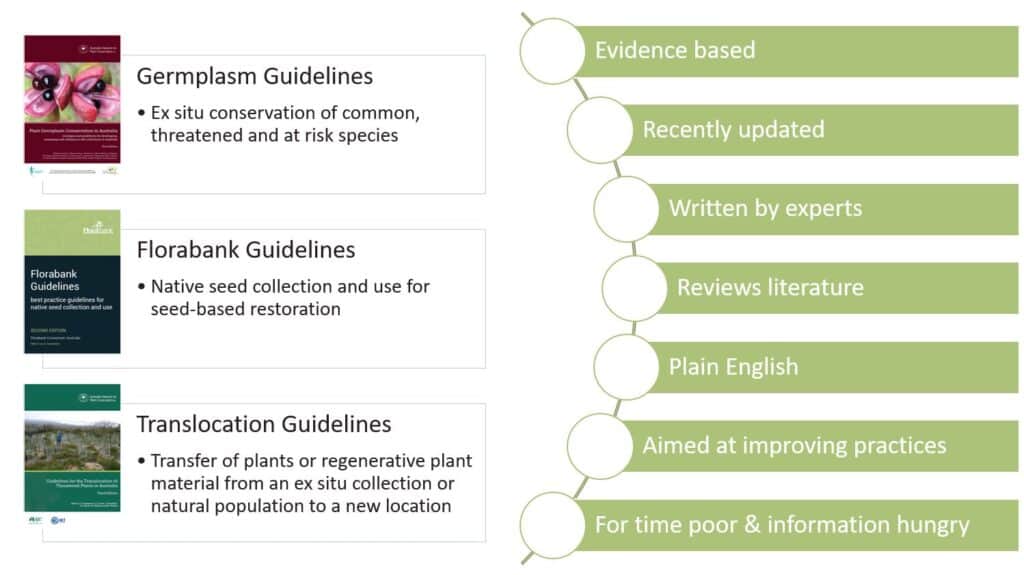
Features of the three guidelines.
Source: Dr Lucy Commander’s presentation at The Biodiversity Conference 2021
Full title: Guidelines for the Translocation of Threatened Plants in Australia
The Translocation Guidelines focus on threatened species, and follow the process of threatened species translocation from planning and preparation to implementation, monitoring and evaluation. This includes advice on both selecting source material and recipient sites.
If you work on threatened plants or are partnering with conservation agencies to produce plants for translocation, this is a key reference. Over 30 experts (scientists and practitioners) contributed to the Translocation Guidelines, through consultation at two workshops, by revising the text of the guidelines and writing case studies. You can read the full versions of the case studies here.
Funding to update and print the Guidelines was received from the National Environmental Science Program’s Threatened Species Recovery Hub (TSR Hub) and the ACT Government’s Environment, Planning and Sustainable Development Directorate.
Full title: Florabank Guidelines – best practice guidelines for native seed collection and use
The Florabank Guidelines focus on native seeds for restoration, usually of common species. The 15 modules guide readers through the seed supply chain, including species selection, seed sourcing, seed production, seed processing, seed testing, seed storage and seed technology, and assists readers to decide whether direct seeding and/or tubestock will provide the best outcome. It also provides tips on buying and selling seeds, information on working with First Nations Australians, approvals and record keeping.
The Florabank Guidelines focus on restoration using many species which are not threatened, and, assuming the restoration site is already selected, provides advice on selection of species and provenances.
The Florabank Guidelines were updated as part of the Healthy Seeds Project, funded by the NSW Government through its Environmental Trust and overseen by a consortium of several organisations: the Centre for Australian National Biodiversity Research, Royal Botanic Garden Sydney, Department of Planning, Industry and Environment (including the Saving our Species program), Australian Seed Bank Partnership, Greening Australia, Australian Association of Bush Regenerators and the Society for Ecological Restoration Australasia.
Full title: Plant Germplasm Conservation in Australia – strategies and guidelines for developing, managing and utilising ex situ collections
The Germplasm Guidelines focus on ex situ collections of common and threatened plant species, including wild relatives of crop species. Plant tissues (collectively known as ‘germplasm’) can be stored in seed banks, or as tissue cultures, or even in cryostores, as well as in the nursery and in living plant collections. The first two chapters cover the ‘why’ and ‘how’ of ex situ conservation, including a handy decision-making guide and the key considerations for planning.
This third edition includes new chapters to ensure good genetic representation in ex situ collections, an overview of nursery practice (including must-read sections on propagation techniques), how to identify species with seeds that are ‘exceptional’ or difficult to store, handling of orchid seeds and mycorrhizae (symbiotic fungi), storage of non-seed plants such as ferns, conservation of carnivorous and parasitic plants, and the use of ex situ collections. It also includes many case studies, a selection of which you can read here.
The Germplasm Guidelines were updated with funding from The Ian Potter Foundation, in partnership with the Australian Seed Bank Partnership and the assistance of the restoration and agriculture sectors, botanic gardens, CSIRO and universities.
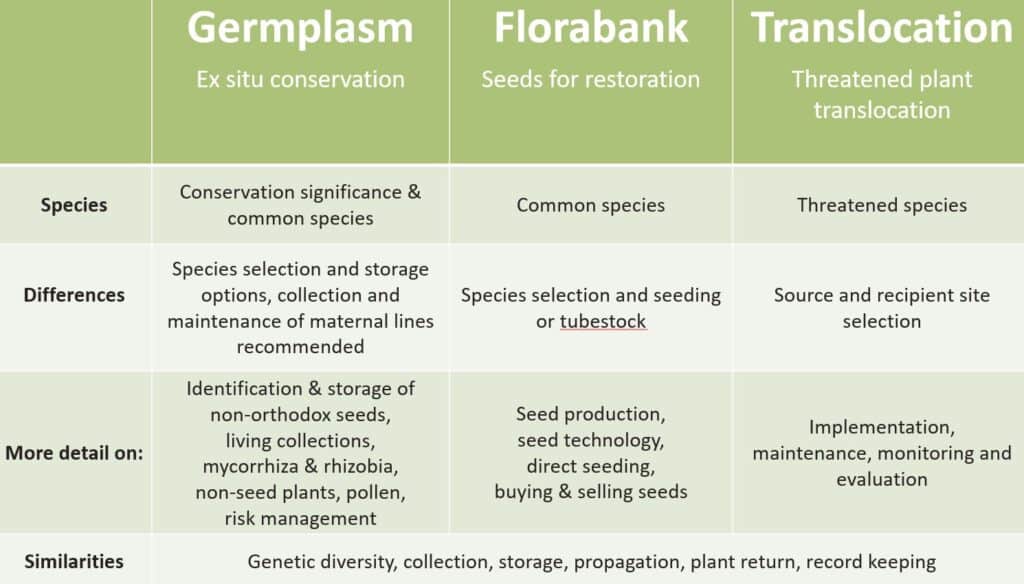
Summary of the similarities and differences of the guidelines.
Source: Dr Lucy Commander’s presentation at The Biodiversity Conference 2021
Global applications
These guidelines were revised to provide practical examples of application in a local context and familiar flora. So, while the three Guidelines are written for management of Australian plant species and use examples and case studies from Australia and New Zealand, many of the approaches, techniques and technologies are applicable to plants across the globe.
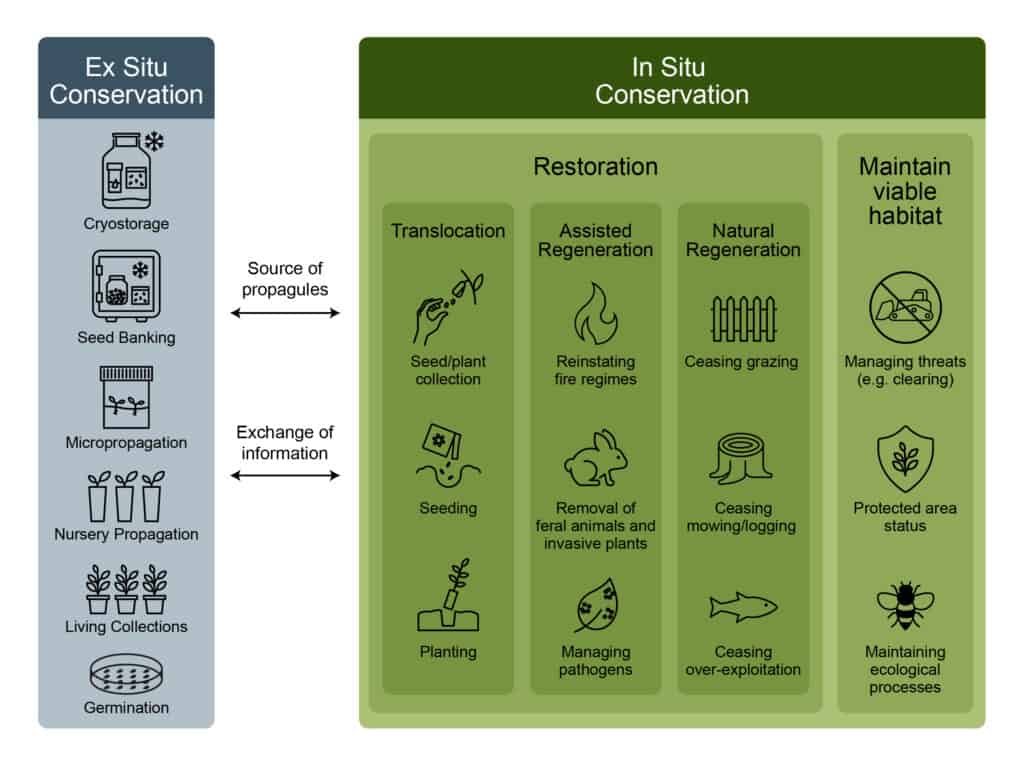
Processes in the guidelines that contribute to restoring Australian landscapes through plant return to natural habitats
Source: Commander LE, Offord CA, Auld TD (2021) FloraBank Guidelines Module 1 – Introduction. In ‘FloraBank Guidelines (2nd edn).’ (Ed. LE Commander) (FloraBank Consortium: Australia)
This webpage is based on information from the following articles:
Martyn Yenson, A. (2021) Best Practice Guidelines a Win for Collaboration. THE BOTANIC GARDENer, issue 57 available from https://issuu.com/bganz/docs/tbg_iss57_dec2021_final_211129/30
Martyn Yenson, A., Commander, L.E., Offord, C.A. and Auld, T.D. (2022) Forward Together: ANPC-led Guidelines informing conservation, restoration and translocation practice. Australasian Plant Conservation, Vol 30 (3).
